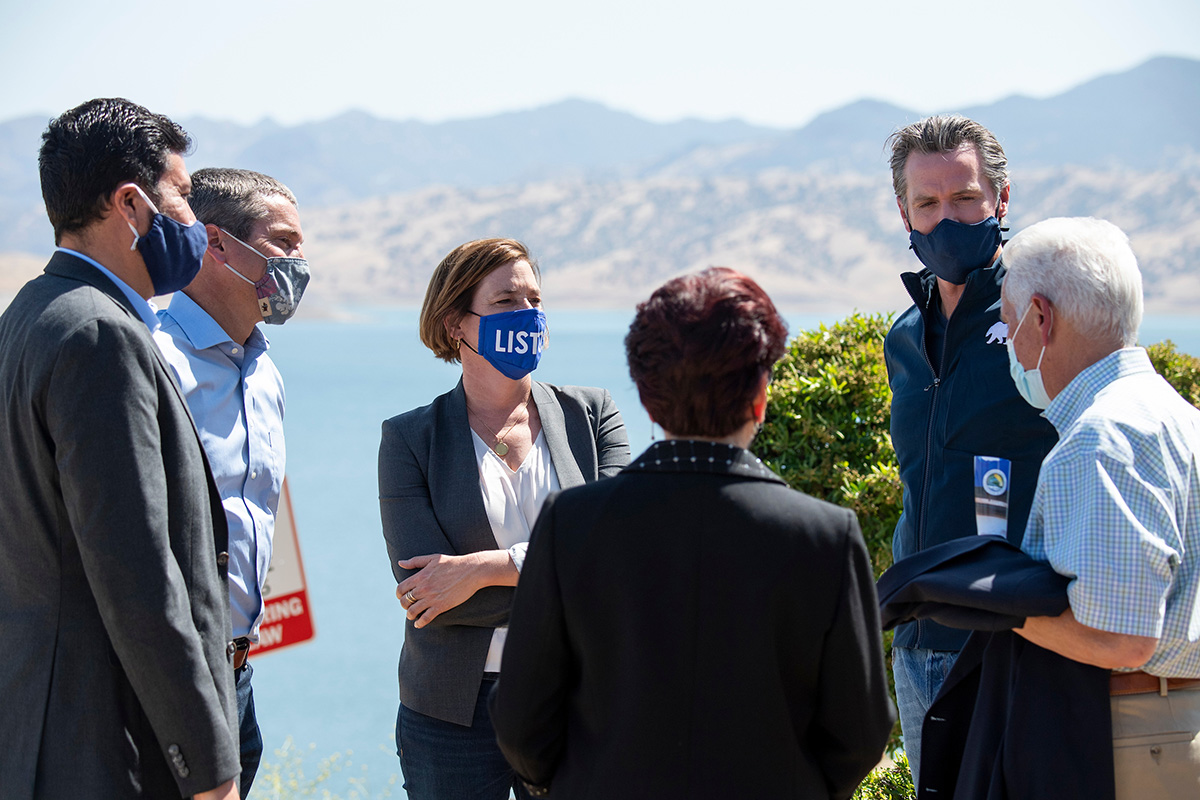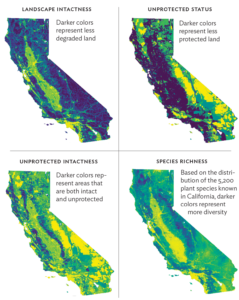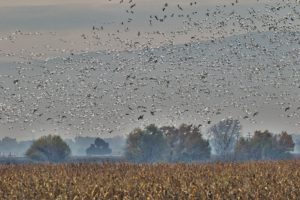California Governor Gavin Newsom’s recall election in mid-September, should he lose, will very likely terminate the floundering politician’s career. A late-term gubernatorial replacement would also mean a potentially major shift in California environmental policies. If voters yank Newsom, a Democrat, from office, he is likely to be replaced by a Republican. The leading candidate, Larry Elder, is a far-right conservative and libertarian who calls climate change a “religion.”
Newsom and his supporters warn that replacing him with Elder, best known as a talk show host, risks rollbacks of state fracking bans and executive orders targeting greenhouse gas emission reductions, fuel efficiency, and biodiversity conservation. The agenda of a new administration could, they say, be a disaster for California’s environmental policies and role as an international environmental leader – and would come on the heels of the United Nations’ report warning of cataclysmic and inevitable climate change and the need to curb emissions.
“A new governor right now could scuttle everything,” says Daniel Gluesenkamp, executive director of the California Institute for Biodiversity and former executive director of the California Native Plant Society.
Budget spending, he says, could be directed away from hundreds of conservation projects that are tentatively scheduled to begin, and directors of wildlife, water, and resource agencies who were appointed by Newsom would almost certainly be replaced.
“That will kill initiatives that are right now at their fledgling state,” Gluesenkamp says. “A new governor could very quickly redirect people’s time and energy away from these environmental and biodiversity initiatives.”
Newsom’s supporters have applauded his recent policy actions. In late 2019, Newsom signed an executive order calling on state agencies to pick up the pace on phasing out greenhouse gas emissions, and a year later he committed California to banning the sale of emission-producing vehicles by 2035. In July, he signed an emergency proclamation to expedite clean energy projects to lighten the strain on the state’s beleaguered electrical grid. This spring, he rallied his own officials to cease issuing fracking permits by 2024, and in July and August, his administration denied dozens of oil drilling and fracking permits. Newsom has launched an initiative aimed at protecting 30 percent of the state’s land and water by 2030. His energy regulators recently mandated that most new building be fitted with solar panels starting in 2023.
Republicans in the State Legislature have sharply criticized Newsom’s push against polluters and the oil industry, and it seems probable a Republican governor would shift policy – or at least try to – to align with these interests. According to a report by Sierra Club California, fossil fuel emitting industries donated $2.3 million to the California Republican Party in 2019 and 2020, compared to $750,000 to the California Democrat Party.
Michael Mantell, president of the Resources Legacy Fund, says several “Trumpian mentalities” on the recall ballot pose a serious threat to the state’s policy directions and the environment itself.
“Any policies Newsom initiated by executive order could be canceled instantaneously,” Mantell says.
Even projects with approved funding could get killed or indefinitely stalled. The state’s general fund contains $3.7 billion earmarked for climate change resilience projects and, Mantell says “it could be totally wiped out.”
The state’s Democrat-majority Legislature could restore such changes, but “it would take a two-thirds vote,” Mantell says.
Projects funded with bond dollars would also be vulnerable. While such money could not, per state law, be redirected by the governor, the governor’s “hidden power” would simply be to freeze it, says State Senator John Laird, D-Santa Cruz, who served as the California Natural Resources Secretary for eight years under Governor Jerry Brown.
“The governor couldn’t change the earmark, but they could just choose not to spend the money,” Laird says.
Thanks to a huge budget surplus for the coming fiscal year, there is a long list of environmental projects Newsom has said he intends to fund but that could easily be trashed or shelved.
“[A new governor] could choose to not expend money for the program to limit greenhouse gas emissions in airports,” Laird says. “He could choose to not spend bond money on land conservation. He could choose not to spend money on planning for sea level rise. He could choose not to spend money on wetland acquisition and protection.”
Other specific projects and programs that could be canceled or halted by a new governor include several dam removals, an effort to save the monarch butterfly from extinction, restoration of Stiver’s Lagoon Marsh, hundreds of state park upgrades, and habitat restoration work in the Pacific Flyway. The Sonoma Valley Wildlands Collaborative is conducting fuel and vegetation management to reduce fire risk on thousands of acres of land imminently threatened with wildfire, and that could be nixed. So could funding for The Marine Mammal Center and the new Cutting the Green Tape Initiative, which aims to streamline bureaucratic hurdles that often stall restoration work.
Mantell says $300 million of general fund money that might soon be awarded to the San Francisco Bay Restoration Authority to protect shorelines against rising sea level could be spent elsewhere if the recall succeeds and a climate change naysayer takes office. Additionally, $1.3 billion now allocated to safe drinking water and safe sewage disposal programs could be redirected, as well as $525 million to the state’s Clean Vehicle Rebate Project.

While a general election is 14 months away, it is relatively unlikely to generate unpopular upheaval in the same way that a recall can. Indeed, the political flammability of the recall is a result of the way the ballot is designed.
The ballot asks voters a yes-or-no question about whether to remove the governor. A second question on the same ballot asks voters to choose from among 46 candidates to replace Newsom. If the “yes” choice receives the most votes, whichever candidate gets the highest percentage of the vote becomes the new governor. Polls generally show voters split on the first question, with Elder leading the crowded field of replacements with around 19 percent.
“Forty-nine percent of people might want Newsom to remain governor, and so he’d be recalled, and then he might be replaced by a candidate who only got 15 percent of the votes,” Mantell explains.
Laird says that because a candidate can win with such a small percentage, the recall process poses the unique risk that “someone completely out of sync with the people of California” will become governor.
“State voters are overwhelmingly committed to combating climate change, and yet there are some candidates who have climate change deniers backing them,” Laird says.
A recall of Newsom might also rock the boat on current state efforts to improve relations with disenfranchised Indigenous groups. Early in his term, Newsom formally apologized to Tribal leaders for historic atrocities committed against Native Californians statewide. Since then, his administration has forged ahead with programs that are returning large swaths of land to the Native Californians who live on them. Some have characterized this landscape-level repatriation as the most effective climate mitigation scheme, because it returns carbon-stocked forests and soil to the land stewards who know best how to preserve such acreage for the long run – Tribes like the Yurok, Kashia and Esselen. Newsom’s Secretary of Natural Resources Wade Crowfoot has led much of the outreach toward Tribal leaders, and he is among the appointed officials that would almost certainly get the boot by a new governor aiming to reset California.
The California League of Conservation Voters, the NRDC Action Fund, and many other groups are encouraging voters to vote no on the recall and leave the box for choice of candidates unchecked.
Mary Creasman, the CEO of the California League of Conservation Voters, warns that a successful recall of Newsom could lead to “a Trump-era moment of pushing back, of anti-environmental regulations.”
At the NRDC Action Fund, senior advisor Victoria Rome says executive orders are the policy actions most vulnerable to changes of leadership.
“Newsom has issued several important executive orders, on clean cars, preserving 30 percent of nature, and phasing out oil and gas production,” she says. “Those are important signals to the rest of the world, and a new governor could issue their own executive orders and set that progress back.”
Other environmentalists, though, have not been thrilled by Newsom’s track record.
Patricia Schifferle, the director of the conservation group Pacific Advocates, commended the Newsom Administration’s actions to protect the McCloud River against the raising of Shasta Dam – a proposal that was backed by Republicans. She’s frustrated, however, by state policies that favor the agriculture industry over the environment. She points back to late 2019, when Newsom vetoed SB 1, a proposed law that could have effectively safeguarded California’s environmental laws against any federal-level rollbacks signed off by then-President Trump. The farming industry, irrigation districts, and conservative lawmakers opposed it.
“He caved to the extractive industries and didn’t sign it into law,” she says.
Still, Schifferle fears a Republican governor would be friendlier than Newsom has been to the agriculture industry, as well as oil, mining and timber interests.
“The extractive industry and the irrigators would welcome a change to Republican leadership, because they would be able to take more public resources for their own private gain – there’s just no doubt about it,” she says.
For some conservation advocates, at least, a Republican in office is a risk they are willing to take.
“I either won’t vote, or I’ll vote against him,” says a California conservation advocate who spoke with Bay Nature on the condition of anonymity. They expressed frustration with Newsom’s tendency to set lofty conservation and climate goals for dates far in the future, beyond the control and lifespan of his administration. Newsom has also been criticized for his management of the state’s rivers, which are currently beset by fish kills and toxic algal blooms.
Another source feels Newsom “has been terrible on environmental issues” and thinks the prospect of Elder, or another Republican, isn’t so bad.
“He’ll be constrained by a Democratic legislature, and he’ll only have one year to get anything done, and then he will likely be replaced by another Democrat,” the source says.
NRDC Action Fund senior advisor Rome believes the recall is very unlikely to succeed and that, ultimately, the recall proponents are attacking values too strong to topple.
But Creasman says the notion that California is an everlasting stronghold of progressive ideals and environmental values is false.
“People see California as a progressive haven, but it’s not,” she says. “A shift to a Trumpian regime could be a reality.”
Gluesenkamp says California has made progress for decades, reversing course “from a government that was hostile to the environment to the one that we have now.”
“It’s frightening how easily we could be stopped in our own progress and get set back,” he says. “It would just take a big personality with low competence.”





